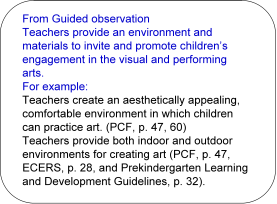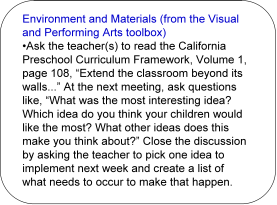
Introduction
INTRODUCTION
Providing technical assistance to teachers may sometimes feel overwhelming. Where is the best place to begin? How should development issues be prioritized? What is the best way to offer meaningful professional development to teachers? This trainer’s manual is organized to help trainers guide teachers in supporting visual and performing arts development. Guidance from a trainer or mentor enables teachers to better understand strategies which foster visual and performing arts development in early childhood. This manual is designed to do the following:
- Help identify and address specific teacher needs
- Provide an array of training ideas and strategies from which to choose
- Offer useful resources related to visual and performing arts development from both California Department of Education (CDE) documents and outside sources
GUIDED OBSERVATION
The first section of the manual, Guided Observation, simplifies the observation process by using content from the California Preschool Curriculum Framework (CDE, 2010) to outline practices in the classroom that support children’s visual and performing arts development. Each section offers concrete examples of what the practice might look like in a preschool classroom; for example, the observation that a teacher provides an environment and materials to invite and promote children’s engagement in the visual and performing arts, might be reflected in a classroom where teachers provide both indoor and outdoor environments for creating art.
It is important to note that the examples listed are simply examples for each of the practices and that a teacher might demonstrate each practice in a multitude of ways. The guided observation is not intended to be used as a classroom or teacher assessment, but rather a guide to assist efforts in supporting teacher practice. References are provided following each example. The abbreviations refer to the resources listed in the CDE Resources section of this trainer’s manual. The cited references are as follows :
:
- Preschool Curriculum Framework (PCF)
- Preschool Learning Foundations (PLF)
- Early Childhood Environment Rating Scale (ECERS)
- Preschool English Learners Resource Guide (PEL)
- Desired Results Developmental Profile© (DRDP©)
- Learning and Development Guidelines
TOOLBOX
Once a trainer observes the teacher and environment using the Guided Observation in the trainer’s manual, he/she will have a general idea as to which areas a teacher might need additional support and/or coaching. The Professional Development Toolbox section offers professional development strategies and ideas for each of the practices listed in the Preschool Curriculum Framework. It is recommended, however, that before using the toolbox, teachers be given the opportunity to conduct a self-evaluation using the Guided Observation.
From the self-evaluation process, teachers will identify their strengths and one or two areas requiring assistance. Given the information from the self-evaluation in addition to classroom observations, the trainer will be able to best identify which coaching strategies/ideas from the toolbox might be most beneficial to the teacher.
Below is an example of the process of collecting data, the type of data which may be collected, and possible course of action.
Information Gathered from Observation
The trainer observes that the art center is well-stocked with a variety of materials and supplies, however there are no opportunities for children to participate in visual or performing arts outdoors.
Information Gathered from Teacher’s Self-Evaluation
According to the information in the self-evaluation, the teacher feels that she provides many opportunities for children to use art media and participate in dramatic play. She integrates music into large and small group activities on a daily basis. There is a shelf stocked with various musical instruments representing multiple cultures.
Using a strengths-based approach, the trainer may share observations that the room is well stocked with visual and performing arts materials. The trainer might probe by asking, “Thinking about what you already do, let’s discuss next steps. What area(s) would you want to enhance?” The teacher might share that she would like some ideas on how to infuse visual and performing arts throughout all the centers of the classroom, including the outdoors..

Gathering information from conversations and interactions with the teacher, the guided observation tool, and the teacher self-evaluation process, will help the trainer determine which strategies from the toolbox might be most beneficial. In this scenario, the information reflects that the teacher may need support in understanding how to create invitations for visual and performing arts, both indoors and out. Though starting with one or two strategies may be most effective, the toolbox offers several ideas that address this area.
RESOURCES
The Trainer’s Manual has two resource sections. The first section provides a list of CDE resources including the California Preschool Learning Foundations, the California Preschool Curriculum Framework, the Desired Results Developmental Profile© (DRDP©), and Preschool English Learners: Principles and Practices for Promoting Language, Literacy and Learning as well as outside resources such as, the Early Childhood Environment Rating Scale (ECERS). For each resource listed, the sections and/or pages that refer to visual and performing arts development in young children are listed below the resource description.
The second section includes additional resources such as websites and articles that address visual and performing arts development in early childhood.
Utilizing and referencing these resources will help teachers become more aware of the research available in the area of visual and performing arts development in early childhood. Moreover, it is highly recommended that teachers read the California Preschool Learning Foundations to better understand typical visual and performing arts development during the preschool years. Additionally, The California Preschool Curriculum Framework will provide teachers with guidance for planning experiences and classroom environments that not only align with the foundations but also are meaningful for young children, developmentally appropriate, and inclusive of children who speak a language other than English in the home and children with disabilities or other special needs.
